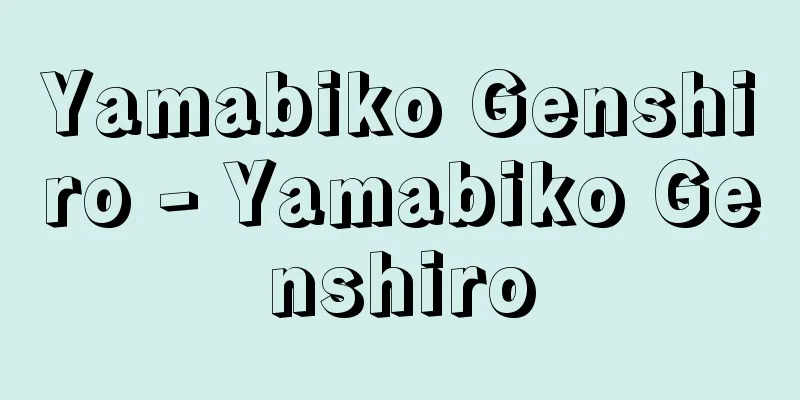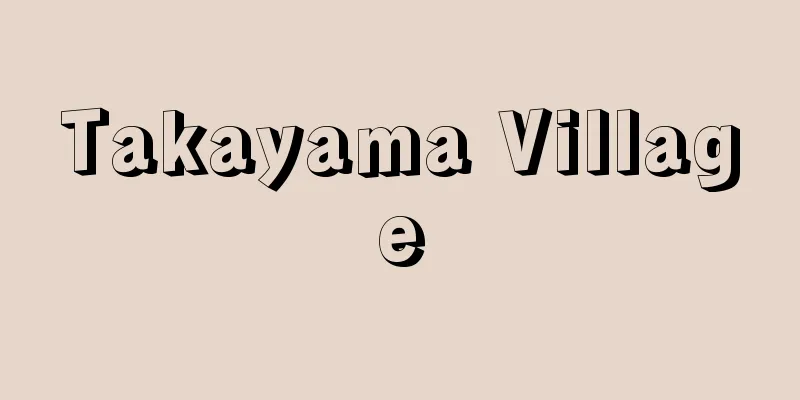Monchu

|
A type of clan organization that developed in Okinawa Prefecture, mainly among the warrior class during the Shuri Kingdom era. In the local dialect, it is pronounced "munchu". It is also called "ichimon" (a clan). It is a group of patrilineal main and branch families, with the main family called "motoya" (moutuya), the head family called "omoto" (uhumutu), and the main family of the branch family called "nakamutu". It is a genealogical group that is specifically linked through ancestral worship. The main family worships its ancestors below the founder, and the branch families at the lowest levels worship all of their ancestors by visiting the ancestors of the main family at each level. However, it was not until 1689 (Genroku 2) when the royal court established a genealogical office and the "family records" were compiled that such genealogical groups were established and the main families below the head family were clearly identified. The "family genealogies" created by the genealogy bureau recorded the samurai's family register and histories of official ranks and positions, and a separate volume was produced when a branch family became the head family. In effect, the head family was the family that possessed the "family genealogy," and so the monchu could be described as a "family genealogical" group. In that respect, the monchu were strongly colored by the royal court's system. To understand the significance of the monchu as a social institution, it is necessary to clarify to what extent earlier traditions survived in the monchu system that came after the "family genealogy." In rural societies made up of commoners, there are also monchu or clan organizations equivalent to monchu. While samurai monchu are not subject to restrictions based on local ties, in rural areas, monchu function within the framework of village organizations, just like ordinary clan organizations. The pioneering old family of a village is called neya (niya), and the monchu of that family is the main body in running the village. In particular, in the case of ritual organizations, the ritual functions of the monchu directly form part of the village rituals. In the Kunigami region, there are villages where the monchu are said to have been jointly responsible for taxes. In these villages, the monchu are equivalent to the Goningumi. However, there are also examples in the Edo period of old village families seeking financial cooperation from branch families on a super-village level for public projects. The existence of clan organizations involves the complex issue of settling in a village or migrating, and the village and super-village functions of the kin are two sides of the nature of the Japanese "ie." Before the "family genealogy," the samurai class must have repeatedly differentiated historically and geographically, and the origin of the "family genealogy" does not date back very far to the Edo period. The spread and differentiation of clans can be compared to the "houses" of medieval Japanese samurai. In the rural areas of the Shimajiri region, there is a custom of using one grave for each family member belonging to a clan, known as monchubaka. This custom is an important bond between clan members, combining the principle of family unity and the tomb system, and is said to have originated from the land use policy of the Shuri Royal Court, which required two clans to use one grave and forbade the creation of new graves. The restrictions on graves led to the development of monchu as a "tomb" group. As in the general rituals of the Ryukyu Islands, monchu have female priests called "kode" (dialect: kudi), and have a strong character as a ritual group, but in essence, both samurai and commoners are genealogical groups based on the "family," and are no different from clans in general Japan. The dialect equivalent of monchu is "hara." It is used, for example, as in "Kouchibara Monchu." Hara is probably the same word as "hara" (belly), which means clan and has traces in ancient Japanese. Monchu was used by the Gozan monks to refer to the temples of the same clan, such as the main temple and branch temples, and appears in the royal court's "Ryukyukoku Yuraiki." It is likely that it became popular as a Chinese word to mean clan, and was used by royal court officials as a legal term. [Yo Kojima] Source: Shogakukan Encyclopedia Nipponica About Encyclopedia Nipponica Information | Legend |
|
沖縄県で、首里(しゅり)王府時代の士族階層を中心にして発達している同族組織の一種。方言ではムンチューと発音する。一門(いちもん)(イチムン)ともいう。父系的な本家・分家の集団で、本家を元家(もとや)(ムートゥヤー)といい、総本家を大元(おおもと)(ウフムートゥ)、支族の本家を中元(なかもと)(ナカムートゥ)とよぶ。祖先祭祀(さいし)を通して具体的に結び付いた系譜的集団である。本家には、その家をたてた元祖以下の祖先が祀(まつ)ってあり、末端の分家では、各段階の本家の祖先に詣(もう)でることによって、すべての祖先を拝むことになる。しかし、このような系譜的集団が確立し、大元以下の本家が明確になるのは、1689年(元禄2)に王府に系図座が設けられ、「家譜」が整備されてからである。系図座で作成された「家譜」は、士族の戸籍と官位・官職などの履歴を記したもので、分家し、支族の本家になると別冊がたてられた。事実上、本家筋とは「家譜」をもっている家ということで、門中は「家譜」的集団ともいえる。その点では、門中は王府の制度の色彩が濃厚である。社会制度としての門中の意義を理解するには、「家譜」以後の門中制度のなかに、それ以前の伝統がどれだけ生きているかが解明されなければならない。 庶民階層からなる農村社会にも、門中あるいは門中に相当する同族組織がある。士族の門中は地縁的規制を受けないが、農村では一般の同族組織と同じく、村落組織の枠のなかで門中が機能している。村の草分け旧家を根屋(ねや)(ニーヤ)といい、その家の門中が村の運営の主体をなす。ことに祭祀組織では、門中の祭祀機能がそのまま村落の祭祀の一部分を構成する。国頭(くにがみ)地方には、門中が租税の連帯責任を負ったと伝える村もある。ここでは、門中は五人組に相当する。しかし、村の旧家が公的な事業には、超村落的に分家に経済的協力を求めている例が江戸時代にもある。同族組織の存立には、村落への定住と移住という複雑な問題があり、同族の村落機能と超村落機能は、日本の「家」の性格の二面であろう。士族も「家譜」以前は、歴史的、地理的に分化を繰り返していたはずであり、「家譜」の元祖は古くても江戸時代をいくらもさかのぼらない。門中の拡散と分化は、日本の中世の武家の「家」と類比してみることができる。 島尻(しまじり)地方の農村などには門中墓(もんちゅうばか)といって、門中に属する家が一つの墓を用いる習慣がある。同族の結合原理と墓制とが一体になった形で、門中の重要な紐帯(ちゅうたい)になっているが、これも首里王府の土地利用政策として、二つの門中で一つの墓を用い、新しく墓をつくることを禁じたのに由来するという。墓が規制されることによって、門中は「墓」的集団として展開することになった。門中には、琉球(りゅうきゅう)諸島の祭祀一般と同じく、「こで」(方言、クディ)とよばれる女性司祭者がいて、祭祀集団的性格も強いが、その本質は士族も庶民も「家」を単位にした系譜的集団で、日本一般の同族と異なるものではない。門中に相当する方言はハラである。「幸地腹(こうちばら)門中」のように用いる。ハラは上代日本語に痕跡(こんせき)のある、一族を意味する「腹(はら)」と同語であろう。門中は、本寺と末寺など一門の寺院をさす語として五山僧が用いており、王府の『琉球国由来記』にもみえる。それを一族を表す漢語として、王府の役人などが法制語のように用いて普及したものであろう。 [小島瓔] 出典 小学館 日本大百科全書(ニッポニカ)日本大百科全書(ニッポニカ)について 情報 | 凡例 |
Recommend
Structural soil
Microtopography is a symmetrical, geometric patte...
'Abd al-Malik al-Aṣma'ī
740‐828 Arab writer and philologist. His real name...
enculturation
… Culture as a way of life is a real object, but ...
Vṛtra (English spelling) Vrtra
…Indra was originally a god of thunder, and was c...
Octoling beetle - Octoling beetle
A perennial plant of the Ranunculaceae family (AP...
Bacchylides
A Greek poet of the 5th century BCE. Nephew of Sim...
Kameiros
…In the vicinity of Ialysos, the base of the Myce...
Carpenter
...Even in areas where wood was scarce and people...
Polycladida
...A general term for flatworms belonging to the ...
Red flower iris - Red flower iris
…Only a few species have been introduced to Japan...
Glycine ussuriensis (English spelling) Glycineussuriensis
…[Maki Sachiko]. . . *Some of the terms that ment...
Media
A witch from Greek legend. Daughter of Aeetes, Kin...
Timur
Founder of the Timurid dynasty. Said to be a desce...
Tadokoro - Tadokoro
This refers to the land held by powerful clans be...
Karna (English spelling)
An ancient Roman goddess. According to the myth to...









![New city [town] - Shinichi](/upload/images/67cbe79020b6f.webp)